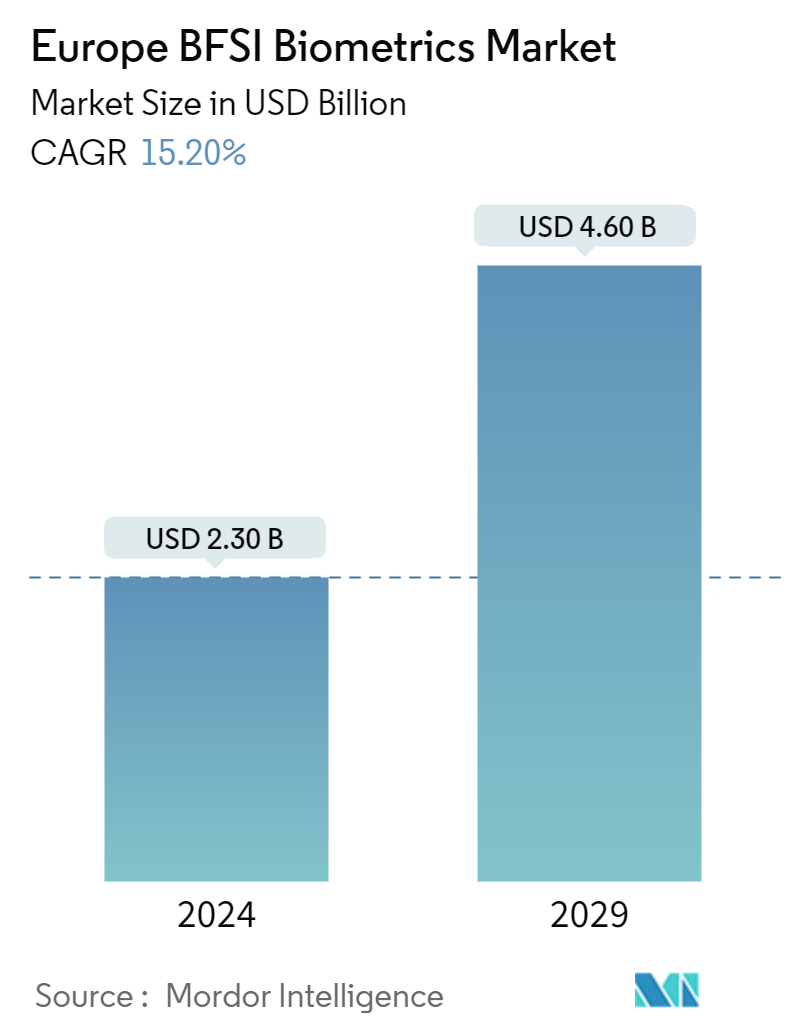Market Size of Europe BFSI Biometrics Industry

| Study Period | 2019 - 2029 |
| Base Year For Estimation | 2023 |
| Market Size (2024) | USD 2.30 Billion |
| Market Size (2029) | USD 4.60 Billion |
| CAGR (2024 - 2029) | 15.20 % |
| Market Concentration | Low |
Major Players
*Disclaimer: Major Players sorted in no particular order |
Europe BFSI Biometrics Market Analysis
The Europe BFSI Biometrics Market size is estimated at USD 2.30 billion in 2024, and is expected to reach USD 4.60 billion by 2029, growing at a CAGR of 15.20% during the forecast period (2024-2029).
- The increasing digitalization of banking services and biometrics enables banks to improve customer engagement levels, which contributes to the growth of this market. The past decade has witnessed substantial transformations in the banking industry as a result of the influence of digitization. The advent of the digital revolution has completely reshaped the manner in which customers engage with their banks and how banks conduct their operations. The introduction of digitization has effectively enhanced the accessibility and convenience of banking services for customers.
- Biometrics in digital banking is increasing as digitalization advances, and banks and financial institutions need to secure authentication systems to enhance customer experience and protect sensitive information. Authentication methods, such as PINs or OTPs, and passwords are easily stolen, forgotten, or compromised. Hence, biometric verification for bank accounts has become increasingly integral to financial industry security platforms. Biometrics helps boost customer trust in banks and improves banking institutions' brand reputation.
- Biometric authentication is rapidly increasing in the banking industry because of the provision of more secure identity verification processes. Changing customer behaviors led to new embedded finance options, such as the emerging buy-now, pay-later models that have gained a significant share. Almost half of Europeans have already used buy-now, pay-later. Poland and Sweden had maximum usage of 62% and 57%, respectively, while the Czech Republic and Austria had 31% and 33%.
- Furthermore, face recognition services were introduced in the retail banking sector for eKYC services, enabling consumers to take a selfie with a smart device and a copy of their identity document, which was shared with a financial institution. The BFSI biometric face recognition technology has been introduced as an authentication method both online and at ATMs, which offers several benefits to consumers and financial institutions as a contactless interface and can reduce instances of fraud and lost cards.
- The high initial investments required for the development of biometric technology, along with the costs of devices like facial, iris, and vein biometry, are primarily due to extensive research and development efforts, as well as the complexities involved in data analysis through embedded devices.
- Additionally, the expenses related to maintenance and data security are crucial, including the need to maintain data security measures such as anti-virus software, encryption-decryption protocols, and other security measures. The costs associated with the biometric systems increase for all the corrective measures and device maintenance. This, in turn, limits banking and financial institutions from investing in these security and identification systems.
- Furthermore, macroeconomic factors such as government regulations on the adoption of the biometrics market, along with the higher interest rate and geopolitical tensions, have affected the demand for biometrics adoption and impacted the market’s growth.
Europe BFSI Biometrics Industry Segmentation
The study tracks the revenue accrued through the sale of biometrics in the BFSI sector by various players in the European region. The study also tracks the key market parameters, underlying growth influencers, and major vendors operating in the industry, which supports the market estimations and growth rates over the forecast period. The study further analyses the overall impact of COVID-19 aftereffects and other macroeconomic factors on the market. The report's scope encompasses market sizing and forecasts for the various market segments.
The European BFSI biometrics market is segmented by authentication type (single authentication factor, multi-factor authentication), contact type (contact-based, non-contact based), product type (voice recognition, facial recognition, fingerprint identification, vein recognition, iris recognition), application (door security, ATM, internet banking, mobile banking, payment authentication), and country (United Kingdom, Germany, France, Rest of Europe). The market sizes and forecasts are provided in terms of value (USD) for all the above segments.
| By Authentication Type | |
| Single Authentication Factor | |
| Multi-factor Authentication |
| By Contact Type | |
| Contact-based | |
| Non-contact Based |
| By Product Type | |
| Voice Recognition | |
| Facial Recognition | |
| Fingerprint Identification | |
| Vein Recognition | |
| Iris Recognition |
| By Application | |
| Door Security | |
| ATM | |
| Internet Banking | |
| Mobile Banking | |
| Payment Authentication |
| By Country*** | |
| United Kingdom | |
| Germany | |
| France |
Europe BFSI Biometrics Market Size Summary
The European BFSI biometrics market is experiencing significant growth, driven by the increasing digitalization of banking services and the need for enhanced security measures. As banks and financial institutions strive to improve customer engagement and protect sensitive information, biometric authentication has become a crucial component of their security frameworks. The shift towards digital banking has transformed customer interactions and operational processes, making biometrics an integral part of ensuring secure and convenient banking experiences. The adoption of biometric technologies, such as fingerprint and facial recognition, is helping to build customer trust and improve the brand reputation of financial institutions. However, the high initial investment and maintenance costs associated with biometric systems, along with regulatory and geopolitical challenges, pose obstacles to widespread adoption.
The market is characterized by a fragmented landscape with several key players, including IDEMIA, Veridium, Thales Group, HID Global Corporation, and Aware Inc. These companies are actively expanding their market presence through product innovations, strategic partnerships, and collaborations. The demand for biometric payment cards is on the rise, with initiatives like the rollout of biometric payment cards by banks such as Crédit Agricole de Lorraine highlighting the growing trend. The increasing prevalence of mobile payment transactions and the push for standardization in the payment ecosystem are further propelling the market forward. As financial institutions continue to embrace biometric authentication to combat fraud and identity theft, the European BFSI biometrics market is poised for substantial growth in the coming years.
Europe BFSI Biometrics Market Size - Table of Contents
-
1. MARKET INSIGHTS
-
1.1 Market Overview
-
1.2 Industry Attractiveness - Porter's Five Forces Analysis
-
1.2.1 Bargaining Power of Suppliers
-
1.2.2 Bargaining Power of Consumers
-
1.2.3 Threat of New Entrants
-
1.2.4 Threat of Substitutes
-
1.2.5 Intensity of Competitive Rivalry
-
-
1.3 Impact of COVID-19 Aftereffects and Other Macroeconomic Factors on the Market
-
-
2. MARKET SEGMENTATION
-
2.1 By Authentication Type
-
2.1.1 Single Authentication Factor
-
2.1.2 Multi-factor Authentication
-
-
2.2 By Contact Type
-
2.2.1 Contact-based
-
2.2.2 Non-contact Based
-
-
2.3 By Product Type
-
2.3.1 Voice Recognition
-
2.3.2 Facial Recognition
-
2.3.3 Fingerprint Identification
-
2.3.4 Vein Recognition
-
2.3.5 Iris Recognition
-
-
2.4 By Application
-
2.4.1 Door Security
-
2.4.2 ATM
-
2.4.3 Internet Banking
-
2.4.4 Mobile Banking
-
2.4.5 Payment Authentication
-
-
2.5 By Country***
-
2.5.1 United Kingdom
-
2.5.2 Germany
-
2.5.3 France
-
-
Europe BFSI Biometrics Market Size FAQs
How big is the Europe BFSI Biometrics Market?
The Europe BFSI Biometrics Market size is expected to reach USD 2.30 billion in 2024 and grow at a CAGR of 15.20% to reach USD 4.60 billion by 2029.
What is the current Europe BFSI Biometrics Market size?
In 2024, the Europe BFSI Biometrics Market size is expected to reach USD 2.30 billion.

